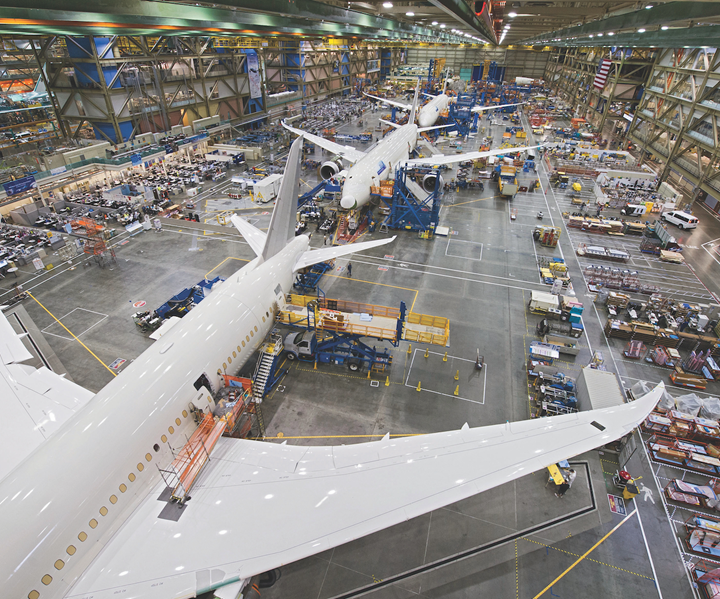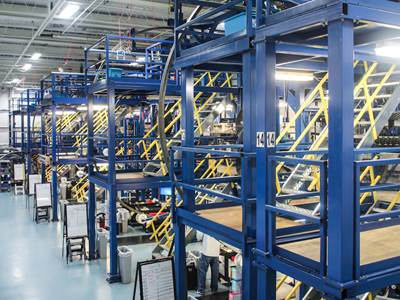What will the aerocomposites industry look like after the 787 and A350?
CW editor-in-chief Jeff Sloan considers the future of the aerospace composites industry as production of the Boeing 787 and Airbus A350 appear ready to wind down in the next few years.

Source | Boeing
Not too long ago, when my three boys were all much younger and in various stages of education and extracurricular activities, my wife and I, like many parents in our position, often found our evenings and weekends consumed by the chore of delivering or retrieving one of our boys to or from school, a practice, a game, a concert or a friend’s house. The logistics of transportation alone were an exercise that was both physically and mentally daunting. And all around us were signs of a family environment that bespoke of the busy-ness in which we lived: Hastily consumed meals, laundry accumulated in intimidating piles, a dishwasher run at least daily, teenage possessions — backpacks, shoes, computers, phones — littering our house.
I remember, at some point during this time in our lives, talking about these challenging aspects of the modern family with the father of a friend of one of my boys. He lamented the difficulty of it all and pined for a day when he would not be so burdened by the work of parenthood. “I can’t wait for this part of my life to be over,” he said.
“Really?” I asked. “Because you know that if you don’t have clothes to wash and carpools to drive and dinners to prepare and dishes to wash, it means your kids are gone — off to college or whatever their next step in life is. I’m not in a hurry for that day to come.”
But, of course, such days do come. Sometimes we see them coming from a long ways away, and sometimes they sneak up on us. Sometimes we are prepared (or, we think we are) and sometimes we are knocked off balance.
I am reminded of this aspect of parenthood because, believe it or not, if you look carefully, it’s not hard to see a future in which we refer to production of the composites-intensive Boeing 787 and the Airbus A350 in the past tense. How, you ask? Well, it’s in the numbers.
Let’s start with the 787. To date, Boeing has received orders for 1,464 787s. At my last check, in mid-September, Boeing had delivered 882 of these orders, which leaves a backlog of just 582 planes. Boeing is currently manufacturing 14 787s a month from its two assembly plants, one in Everett, Wash., and the other in North Charleston, S.C. If Boeing does not receive another 787 order, it will take the company 42 months — 3.5 years — to produce the backlogged orders. Of course, Boeing will receive more 787 orders, but probably only in small increments that will be relatively easy to fill quickly. In short, Boeing will probably face, sooner than later, the prospect of ending 787 production.
The situation at Airbus is similar. The A350 program has 913 planes on order, and 300 of those have been delivered. That leaves a backlog of 613 planes. Airbus is producing 10 A350s per month, but is expected, soon, to increase that to 13 per month. Even if we are conservative and assume a production rate of 10 per month, Airbus will meet its backlogged orders in 62 months — 5 years. At 13 per month, that number is trimmed to 4 years. Like Boeing, Airbus will receive more A350 orders, but those will also be incremental.
All of this is, of course, important to Boeing and Airbus, but it’s equally important to the aerospace composites supply chain, because as these programs wind down, there will be a desire to replace them with something else — a program that is similarly composites-intensive. Such programs are on the horizon, including Boeing’s New Midsize Aircraft (NMA), as well as replacements for the A320 and the 737. However, even if these programs were launched tomorrow, it would be several years before materials and equipment could be committed to production.
It appears, therefore, that there looms on the aerocomposites horizon a gap of uncertainty as the 787 and the A350 wind down and new-program manufacturing ramps up. It remains to be seen what effect this gap will have on the industry, but it’s certainly fair to say that the largesse bestowed on composites manufacturing by the 787 and the A350 programs will be sorely missed, and not easily replaced.
Related Content
Achieving composites innovation through collaboration
Stephen Heinz, vice president of R&I for Syensqo delivered an inspirational keynote at SAMPE 2024, highlighting the significant role of composite materials in emerging technologies and encouraging broader collaboration within the manufacturing community.
Read MoreHow has CW changed in the last year?
Upon his one-year anniversary as editor-in-chief of CW, Scott Francis looks back at some of the brand’s changes and hints at where it might be heading next.
Read MoreWho's ready for the Olympics?
With the 2024 Summer Olympics in Paris, this year’s JEC World is bound to be abuzz with talk of this year’s event — from the use of composites in sporting equipment to the roles they play in AAM.
Read MoreUp, not out: The next chapter of CompositesWorld
I have been editor-in-chief of CompositesWorld for 17 years, which translates into a lot of editorials. This will be my last as I become publisher of CW. We welcome Scott Francis back to the brand to take my place.
Read MoreRead Next
“Structured air” TPS safeguards composite structures
Powered by an 85% air/15% pure polyimide aerogel, Blueshift’s novel material system protects structures during transient thermal events from -200°C to beyond 2400°C for rockets, battery boxes and more.
Read MorePlant tour: A&P, Cincinnati, OH
A&P has made a name for itself as a braider, but the depth and breadth of its technical aptitude comes into sharp focus with a peek behind usually closed doors.
Read MoreCFRP planing head: 50% less mass, 1.5 times faster rotation
Novel, modular design minimizes weight for high-precision cutting tools with faster production speeds.
Read More






















